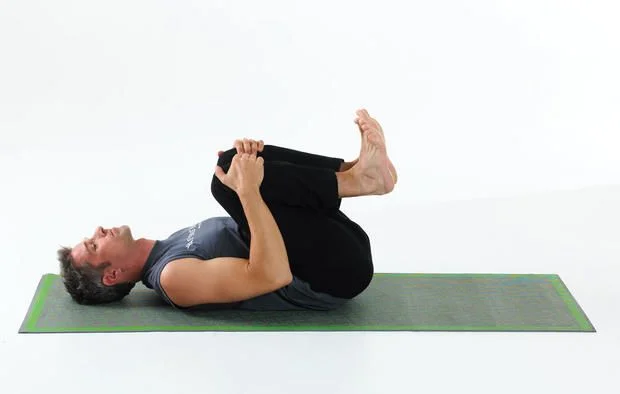What stretching before bed should you do to help you get a good night’s sleep? The answer to these questions can vary depending on your individual needs, but there are some general principles that apply to everyone.
Which stretching before bed is ideal for Doing Right?
Even after you’ve completed your evening routine and are ready for bed, do you still struggle to relax your body and mind? Stretching before bed might be a good idea—it’s really not as hard as you might think!
Let’s look at some stretching exercises you may do before bed to help you unwind from the day and obtain the restorative sleep you want.
Warm-Up Exercises Before Sleep
When performed stretching before bed can help your body and mind relax, lower stress levels, and even enhance the quality of your sleep.
These eight stretches can help you go asleep, remain asleep, and wake up feeling rejuvenated and prepared to take on the day. You can incorporate them into your nightly routine.
1. Child’s Pose
A soothing mind-body practice for relieving any tension in your body is the child’s pose.
This stretch could ease tension in your body, make you feel a little lighter, help you relax, and lessen your back pain.
This is how you should perform this stretch:
- Place your butt on your heel while kneeling on your mat.
- Put your hands forward, lay down on your back, and place your forehead on the mat.
- Put your arms out in front of your forehead.
- Inhale deeply while in this posture.
- Lift your awareness to every region of your body as you release the breath.
- For a duration of 60 to 2 minutes, maintain this stance.
2. Stretch from Knee to Chest

This stretch helps you become more conscious of and release any physical discomfort in your body while also opening up your lower back.
This is how to perform the stretch:
- Your head should be looking up while you lie on your back.
- Using both hands, slowly bring one leg up to your upper chest.
- Till your lower back stretches, give the knee a hug.
- Maintain a calm and straight other leg.
- For 30 seconds, hold.
- Repeat the same motion with the opposite leg after switching.
3. Twist Supine
Supine twists stretch your hips, glutes, and back muscles, which promotes body relaxation.
This is what you should do:
- Lie down on your back.
- Till you feel as though your spine has expanded, bring both of your knees up to your chest.
- Take a breath and bend both knees to the side. Let out a breath.
- Place the upper leg on the lower leg gently.
- Turn your chest to face up.
- For thirty seconds, maintain this posture.
- Continue on the opposite side.
4. Stretch Your Neck
Another stretch that might help your body feel lighter and more at ease for a good night’s sleep is the neck stretch. This stretch aids in the release of tension in the upper body and neck.
This is how you do it:
- Keep your posture straight and pleasant whether you sit or stand.
- Place your right hand over your left ear or the top of your head while keeping your face forward.
- Place your right ear gently against your right shoulder.
- For 30 seconds, hold.
- Change places and carry on.
5. Cat-Cow Stretch

This stretch releases any tension in the area and opens up your shoulder, neck, and lower back.
To perform this exercise:
- To begin, take a neutral stance on the mat by placing your hands and knees there.
- Tighten your core and arch your back upward to strike the cat stance.
- Lift up your head and let your shoulders drop.
- Ten seconds of holding
- Make the cow stance, raising your tailbone upward and thrusting your lower back toward the ground.
- Lean forward with your neck and let your shoulders drop.
- For ten seconds, hold.
- Go back to the neutral stance.
6. Quad Stretches While Standing
A relaxing pose that lengthens the muscles at the front of your thigh is the standing quad stretch. Your body weight is supported by this muscle group when you stand, walk, run, climb stairs, or perform any other leg activity.
This is how to perform the stretch:
- With your body supported by a table or wall, stand up straight. You can perform this pose without assistance if you can keep your balance.
- Using your right hand, bring your right heel back until it about touches your butt.
- With your left knee slightly bent, hold your right foot in this position.
- Hold this posture for thirty seconds.
- Lower your right leg slowly.
- Flip over and carry out the motion once again.
7. Stretch Your Legs Against the Wall
This is a relaxing pose that helps you release tension in your body and lengthen the muscles in your hips, lower back, and hamstrings.
Take these actions:
- Lay down on a mat with your back to the wall.
- Raise your legs and allow them to rest against the wall while keeping your back flat on the mat.
- You’re free to lean your butt against the wall.
- Arms should be resting by your sides.
- Hold this posture for a maximum of ten minutes.
8. Butterfly Pose
You may open up your hips, thighs, and lower back by doing the butterfly stance. It’s great for releasing bottled-up emotions and helping you feel more rooted in your body.
To strike this position:
- Place your feet on a mat and sit up straight.
- Push your heels forward until they come together.
- Separate your knees as much as possible.
- Place your hands on your feet and relax.
- Engage your core and slowly lean forward to your thighs’ middles.
- Extend your spine as far as possible.
- Hold this position for 30 seconds.
- Rep two to four times more.Pose of a Butterfly
What Are the Advantages of Stretching Before Bedtime?
Here are a few benefits that stretching before bed might help your sleep health and overall well-being.
Muscle tightness is relieved.
Stretching before bedtime helps to lengthen muscle groups that may be stiff or tense from the day’s stress or inactivity.
An report published in the International Journal of Sports Physical Therapy said that tight muscles might induce muscle imbalance and impede flexibility. The article also suggested stretching to release muscles and distribute stress across other components such as the joint.
Promotes circulation
Stretching may also help blood flow in your body. According to one study, stretching may improve blood flow, lowering blood pressure and cardiac strain in healthy young adults.
Stretching rats improves blood flow to their skeletal muscle, according to a different animal study. This suggests that stretching can be a useful strategy for older humans who don’t perform aerobic activity to support muscle blood flow.
Control the symptoms of sleeplessness
One sleep disorder that makes it difficult to obtain good, restful sleep is insomnia. Research indicates that stretching can help alleviate the symptoms of insomnia and promote restful sleep.
In persons with persistent insomnia, stretching reduced stress, anxiety, and the intensity of their sleeplessness, according to a 2018 study.
enhances the quality of sleep
Stretching has the potential to soothe and relax your body, lower your stress levels, and ease any pain you may be experiencing. You’re more likely to fall asleep and stay asleep when your body is at peace and tranquil.
Stretching and exercise may enhance the quality of sleep for menopausal and sedentary women, according to a previous study. Similarly, a 2016 study indicates that stretching-based meditative exercises like yoga may significantly improve the quality of your sleep.
reduces back discomfort
Back pain can be uncomfortable, which makes it harder to fall asleep and stay asleep through the night. You can get a good night’s sleep and ease this discomfort by stretching.
Stretching may improve muscular strength and flexibility and lessen lower back pain, according to research. In a similar vein, a 2013 study indicates that stretching may lessen the intensity of persistent low back discomfort.
How long should I stretch before going to sleep?
To relax your body and get it ready for a good night’s sleep, doctors generally advise stretching five to thirty minutes before bed. Most individuals find stretching to be safe, and it can even aid with sleep and fitness.
Think about stretching for a few minutes each day before going to bed! It can be exactly what you need to relax every night.





